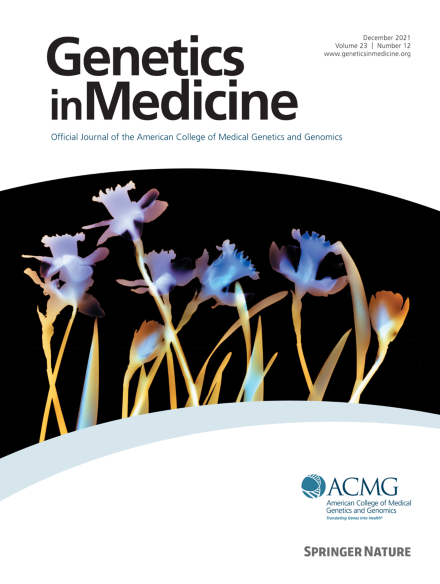RAD51C、RAD51D和BRIP1杂合种系致病变异个体的管理:美国医学遗传学与基因组学学院(ACMG)的临床实践资源
IF 6.2
1区 医学
Q1 GENETICS & HEREDITY
引用次数: 0
摘要
目的:ad51c、RAD51D和BRIP1种系致病变异(gpv)与输卵管卵巢癌终生风险增加相关。临床实践中管理RAD51C、RAD51D和BRIP1杂合子的资源是有限的。方法一个国际工作组开发了一个临床实践资源来指导RAD51C、RAD51D和BRIP1杂合子的管理,使用同行评审的出版物和专家意见。结果rad51c、RAD51D和BRIP1是中(中)外显率的卵巢癌易感基因。RAD51C、RAD51D和BRIP1 gpv患者患卵巢癌的风险可能受到家族史和其他修饰因子的影响。RAD51C和RAD51D gpv也与乳腺癌的中等风险相关,主要是三阴性亚型。基于年龄特异性风险和共同决策,RAD51C、RAD51D和BRIP1杂合子应在接近绝经年龄时进行降低风险的输卵管卵巢切除术。对于RAD51C和RAD51D杂合子,可根据其个性化的风险估计和国家具体指南加强乳房监测。一般来说,不建议进行降低风险的乳房切除术。对于发生癌症的RAD51C、RAD51D和BRIP1杂合子,没有足够的证据来指导任何特定的靶向治疗。结论需要系统的前瞻性数据收集来确定RAD51C、RAD51D和BRIP1相关癌症的结局,特别是对癌症治疗和生存的反应。本文章由计算机程序翻译,如有差异,请以英文原文为准。
Management of individuals with heterozygous germline pathogenic variants in RAD51C, RAD51D, and BRIP1: A clinical practice resource of the American College of Medical Genetics and Genomics (ACMG)
Purpose
RAD51C, RAD51D, and BRIP1 germline pathogenic variants (GPVs) are associated with increased lifetime risks of tubo-ovarian cancer. Resources for managing RAD51C, RAD51D, and BRIP1 heterozygotes in clinical practice are limited.
Methods
An international workgroup developed a Clinical Practice Resource to guide management of RAD51C, RAD51D, and BRIP1 heterozygotes using peer-reviewed publications and expert opinion.
Results
RAD51C, RAD51D, and BRIP1 are moderate (intermediate) penetrance ovarian cancer predisposition genes. Ovarian cancer risks for individuals with RAD51C, RAD51D, and BRIP1 GPVs may be influenced by family history and other modifiers. RAD51C and RAD51D GPVs are also associated with moderate risk of breast cancer, predominantly triple-negative subtype. RAD51C, RAD51D, and BRIP1 heterozygotes should be offered risk-reducing salpingo-oophorectomy close to the age of menopause based on age-specific risks and shared decision making. For RAD51C and RAD51D heterozygotes, enhanced breast surveillance may be indicated according to their personalized risk estimate and country-specific guidelines. Generally, risk-reducing mastectomy is not recommended. For RAD51C, RAD51D, and BRIP1 heterozygotes who develop cancer, there is insufficient evidence to guide any specific targeted treatment.
Conclusion
Systematic prospective data collection is needed to establish the outcomes of RAD51C, RAD51D, and BRIP1 associated cancers and particularly response to cancer treatment and survival.
求助全文
通过发布文献求助,成功后即可免费获取论文全文。
去求助
来源期刊

Genetics in Medicine
医学-遗传学
CiteScore
15.20
自引率
6.80%
发文量
857
审稿时长
1.3 weeks
期刊介绍:
Genetics in Medicine (GIM) is the official journal of the American College of Medical Genetics and Genomics. The journal''s mission is to enhance the knowledge, understanding, and practice of medical genetics and genomics through publications in clinical and laboratory genetics and genomics, including ethical, legal, and social issues as well as public health.
GIM encourages research that combats racism, includes diverse populations and is written by authors from diverse and underrepresented backgrounds.
 求助内容:
求助内容: 应助结果提醒方式:
应助结果提醒方式:


